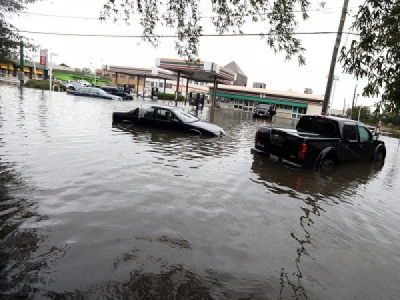
Posted on June 13, 2017
By Eric Hartley, The Virginian-Pilot
David Peronnet had heard about the idea of storm-surge gates on the Lafayette River, which lies just north of his house, and thought, “I don’t even know what that means.”
So he came to a public meeting Thursday night to learn about that and other steps being considered to prevent damage from coastal storms.
The open house was part of a U.S. Army Corps of Engineers study of ways to reduce Norfolk’s flood risk. The Corps will release a “tentatively selected plan” in August, but the study won’t be finished and sent to Congress until early 2019.
Even then, any fixes will probably be years away from construction. They’re all dependent on funding from Congress and matching local money.
And the problems that sparked the study aren’t going away: A state commission found in 2008 that climate change is leading to more frequent and severe storms that produce greater flooding, even as the seas are rising and the land in Hampton Roads is slowly sinking, or “subsiding.”
Carrying out the entire plan for Norfolk would cost billions of dollars, so it’s unlikely everything will happen at once, said Niklas Hallberg, an engineer who works in the Corps’ Norfolk District and helped answer questions during Thursday’s meeting.
A storm-surge barrier on the Lafayette River alone – a step that could help protect Peronnet’s Colonial Place neighborhood, among others – could cost close to $1 billion, Hallberg said.
There are several options for that area, including an “outer” barrier between Lamberts Point and the Norfolk International Terminal and an “inner” one along Hampton Boulevard. Any barrier would include gates that would be open most of the time to allow boats and marine life through, but would close during storms.
Hallberg said most residents he spoke to Thursday night preferred the outer barrier, which would be longer and more expensive but would protect more homes.
Among the other plans being considered: raising the existing downtown floodwall and extending it through Freemason and east along the Elizabeth River; building floodwalls and berms along the coast through Berkley and Campostella; and a storm-surge barrier across Broad Creek at Interstate 264.
There are two options for the flood-prone area around the Hague: a storm-surge barrier, which would be closed only during storms, or a floodwall, which would permanently separate it from the Elizabeth River.
Thursday’s meeting at the Lamberts Point Community Center didn’t include a formal presentation. Eight poster boards were set up on easels around a room, each with one or more Corps representatives to answer questions from the dozens of residents who walked around. There was a red comment box on a center table.
A couple of posters defined the process and the measures being considered, including floodwalls, levees and elevated houses. The rest of the posters showed maps of parts of the city and possible ways to protect each. City officials, who co-hosted the meeting, roamed the room talking to residents.
Many people, including Peronnet, quickly found the poster showing their neighborhood.
“It’s a little bit of a shock to see the words ‘acquisition’ and ‘relocation’ on top of our house,” Peronnet said.
The plans don’t include that level of detail, but his neighborhood was in an area shaded purple, which indicates a history of flood insurance claims. And one possibility is to buy up houses that it doesn’t make financial sense to protect.
Susan Conner, who heads the Corps’ local planning and policy branch, said the study takes into account a 50-year forecast for how flooding could affect every part of the city and each of its 63,000 structures.
The final plan, called the Norfolk Coastal Storm Risk Management Study, will be based on the cost of each fix and how much damage it would prevent. The analysis will take into account property values, but also historical, cultural and socio-economic value, Conner said. Otherwise, neighborhoods with lower property values could go unprotected.
There will be more chances for public input next year, and people can email comments any time to NorfolkCSRM@usace.army.mil. A presentation given recently to the City Council can be viewed at www.nao.usace.army.mil/NCSRM
Terry Legg, a civil engineer whose firm builds floodwalls, commended the city and the Corps for planning ahead instead of waiting for a major disaster.
“Of course, the big question is funding,” Legg said. “And that’s up to Congress. And we know how that works.”
Source: The Virginian-Pilot





